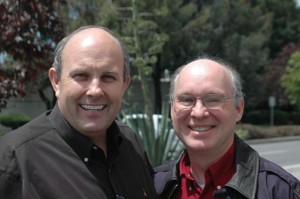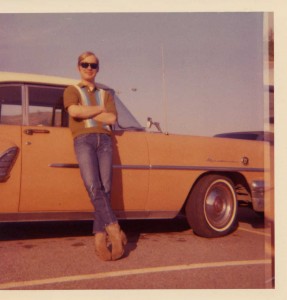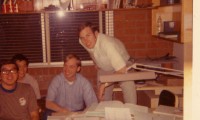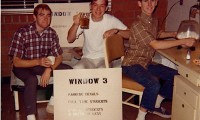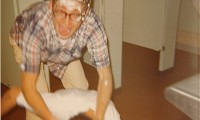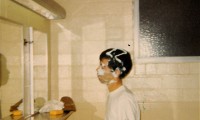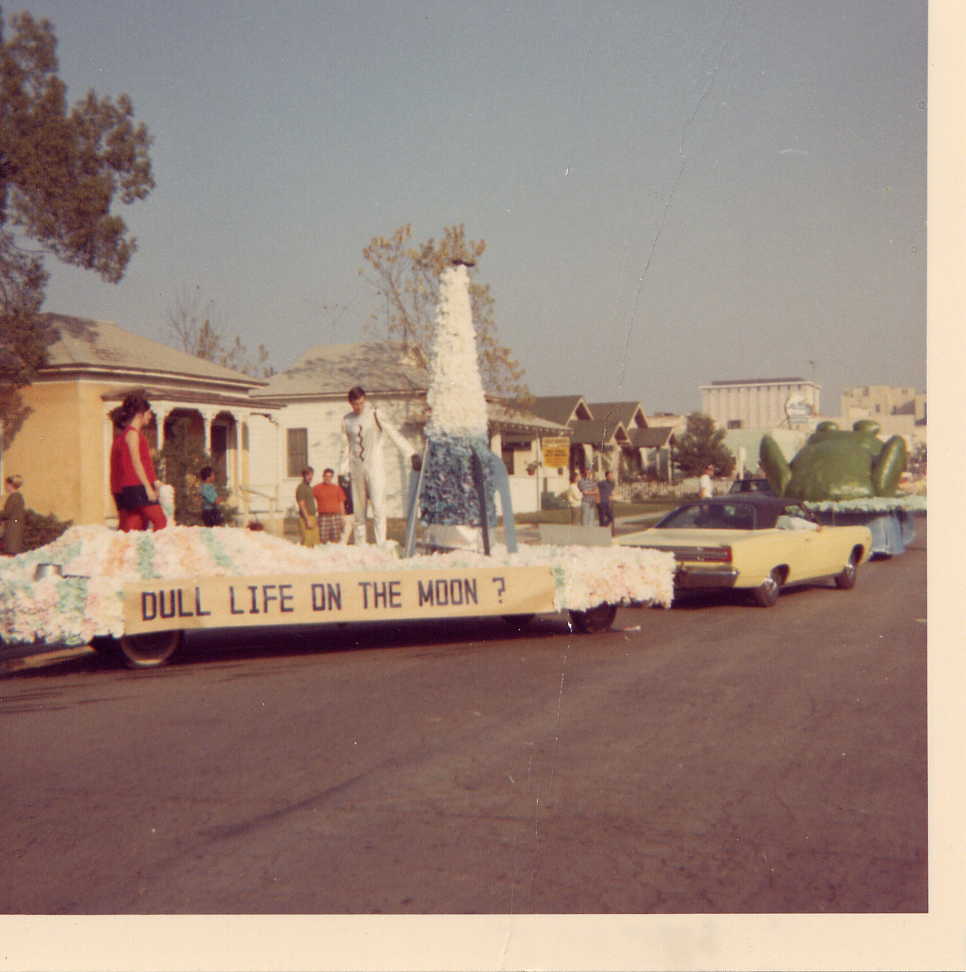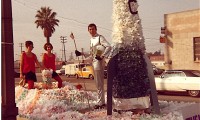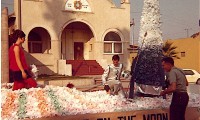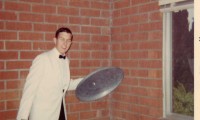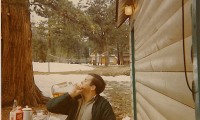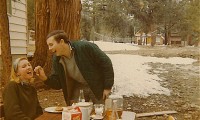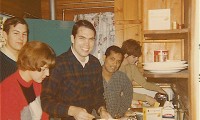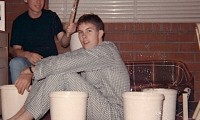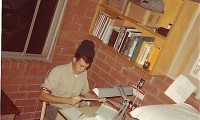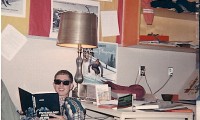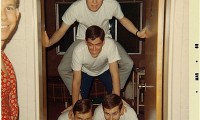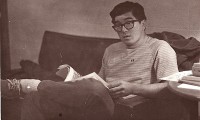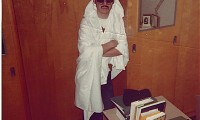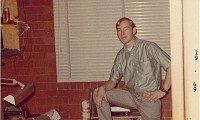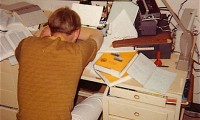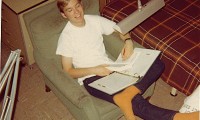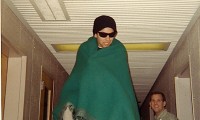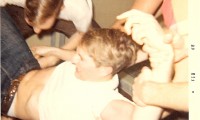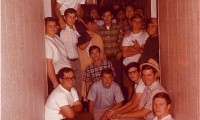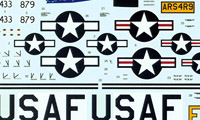This is a picture of my dad when he was a cadet in the Army Air Corps. Next is a picture of my mom when she was in the Navy during WWII. Following is a short story of his life.


THIS IS A BRIEF SKETCH OF THE LIFE OF FLOYD CLARON BISHOP
(Typed from Floyd’s notes by Paul Bishop Jan 10,2005)
I was born in Delta, Utah on June 1st, 1923 to Raymond Spencer Bishop and Annie Maria Hilton. I was the 6th boy in the family – Grant, Duane (Dewy), Merlin, Shirl then me. Later two girls joined us – Cheryl and Rayda.
My parents were very religious and took us to church most every Sunday. It was two and a half miles to town so going three times every Sunday we spent a lot of time on the road. As a Deacon we used to sit on the back row. Bro. Terry, the Bishop’s counselor – used to come to church late every time, he would go sit by the Bishop and we’d bet how long before he would fall asleep – usually three or four minutes.
We were raised on a farm; about sixty acres and a hundred yards from the Severe River. Dad had several other farms so we were kept busy most of the time. We had an hours work to do every night and morning. Milking cows, separating the milk from the cream, feeding the cows, horses, sheep and hogs. I was five years old when I started to milk. At first it was fun till I found out I had a steady job, and I couldn’t quit whenever I wanted to.
I remember our life on the farm riding horses, usually double, of hunting quinps, rabbits and carp with a 22 rifle, hunting ducks, geese and pheasants with Dad’s 12-gauge shot gun; ice skating on the river and reservoir; swimming in the river and going through the flumes; there were lots of fun things to do. I also remember playing on the railroad trestle and setting on the edge of the long ties when the train would come. I played lots of rotation softball with my brothers and also touch football every thanksgiving afternoon and 4th of July. Shirl and I used to fight a lot till he found he couldn’t whip me so he quit trying.
Shirl and I played football in high school together – I was right guard and he was left end my junior year. During the playoff game I cracked my hip. I had felt some pain during the game and mentioned this to the coach and he brushed it off and told me to go back in. Later when the doctor said I had a cracked hip the coach felt really bad and apologized to me. Later Shirl played on the basketball team and I had to milk his cows every night while he practiced. During my senior year I played football again and was the right end. We played both offense and defense. Therman Moody and I were co-captains of the team.
When it came to work though, I remember how hard it was to get those great big horses to stand still so we could put the harnesses on them and not be stepped on; of cutting, raking, pitching, tromping (and getting clobbered by two piles of hay at the same time); of tipping over loads of hay while trying to cross ditches enroute to the stackyard; of the Jackson fork and derrick and how well Dad could build a straight square stack. I remember cutting, pulling, hauling and threshing alfalfa seed, and wheat and barley.
Growing up during the great depression in a small town was not that bad. I remember that we had plenty of food (we raised all of our food and meat on the farm) – no one had any money to spend. Families living in the cities were out of work so they came back to live on the farm with their parents so they could eat.
I rode my own horse to kindergarten when I was five years old. One day my horse got loose and went home – I had to walk home alone.
I remember one summer we were railing brush. We had two teams of horses, one on each end of a 20-foot railroad rail. There was a long chain from the end of the rail to each team of horses. We would stand on the rail and ride it while railing the brush and some times we would get a large pile in front and the rail would ride up over the brush and some times we would be 6 feet in the air on top of the brush.
Dad had 5 teams of draft horses and 2 riding horses. We spent a lot of time driving a team of horses on an alfalfa hay mower or a side rake or on a hay wagon. One day while hauling hay the team was frightened by horse flies and started to run, I was on the load of hay and was reaching down to get the lines tied to the top of the ladder when the horses tried to cross a ditch. The front wagon wheels became stuck in the bottom of the ditch and I was thrown head first down behind the horses and hit my head on the wagon tongue. The wagon was stuck in the ditch and I was shook up but not injured.
We had one old bay mare that liked to stand on both of our feet as you stepped up to put the collar around her neck, so whenever we had hired help we would have them harness up old Pete. This was always good for a laugh.
I remember Stake Conference in 1938. Richard R. Lyman said absolutely there would be no war in Europe. Ted was on a mission to Prague Czechoslovakia and taken hostage by the Gestapo and held for ransom. We didn’t hear from Ted for two months – my parents worried!
Went to Jr. College in Cedar City and worked for $.30 per hour. Then came Pearl Harbor. Merlin was in the Navy Air Corps. He would write and tell about his training and how tough it was cause he knew I wanted to join the Army Air Corps and he wanted to scare me off.
During the summer of 1942 I farmed and worked at Topaz. First chance we had to make some money. Everyone was either being drafted or was enlisting in the service.
At the fall of 1942 I attended college at Utah State. It was hard to study as the tension was high – everyone was leaving school for the service.
Spring of 1943 – Shirl left for the Army Air Corps. Dad wanted me to stay home and help him farm, but I just had to go into the service. Dad was very understanding and only asked me once.
I went to Salt Lake City to enlist. During the physical I failed the blood pressure test. An old sergeant there told me to go eat a bunch of bananas and come back in a few hours. I followed his advice and laid down for a while then went in and passed the physical with no problems. (I added this and since have my doubts that this is true – I think I’ve confused this story from somewhere else – I do remember dad telling me that he took Shirl’s eye test, and that Shirl took his blood pressure test – Paul)
July of 1943 I went to Sheppard Field Texas for basic training for the Army Air Corps – it was a rude awakening to the outside world. Six weeks later I went to Austin College at Sherman Texas for college prep course in math for preflight and ground school. This was because most cadets were 18 and just out of high school and hadn’t enough math – I used to tutor the cadets in my room at night preparing for tests – especially in physics and trigonometry.
November 1943 I went to San Antonio Classification Center for a week of testing to determine type of training. Also another physical exam and had to sweat it out. I was selected for pilot training.
January 1944 – at last preflight – lots of tough classes and physical training.
Shirl was in advanced navigation school at Hondo Texas and would occasionally come to spend the weekend with me. He was a great morale booster. Merlin was flying Martin Mariner PBM anti submarine patrols in the South Pacific at this time. My 3 oldest brothers were married and were farming – all were BYU graduates. Mona’s brother Dale was flying TBM torpedo bombers from a carrier in the South Pacific and later off of a jeep carrier in the Atlantic.
Finally – primary flight school at Cuero Texas – we flew PT-19’s at a civilian school with civilian instructors and had military check pilots.
Then came my solo check ride with “one ride Johnson”. My first instructor had 5 students – and on our first 20-hour check ride I was the only one of the 5 to pass.
Then I went to basic flying school at Waco Texas and flew the PT-13 Vultee Vibrator WC78. While there we had our first night of solo flying – one cadet landed on the ramp and wrecked a bunch of planes. One morning we talked to cute WAAF pilot just before she took of in a BT-13 for a test hop. She crashed into the runway and was killed.
[Addition by Paul Bishop]: this was Betty Mae Scott:
July 26, 1921 – July 8, 1944
Class: 44-W-3
Entered Army Air Force flight training: Avenger Field, Sweetwater, Texas, October, 1943
Graduated: April 15, 1944
Assignment: Engineering test pilot
Assigned bases: Waco Army Air Field (Tex.)
Planes flown: B-13, PT-17, AT-6
She was checking a BT-13 on July 8, 1944. She looked over the Form 1-A from the mechanic which was the only indication as to the plane’s flight worthiness. At the end of the runway, she checks the functioning of all the control surfaces and the engine gauges. However, after leaving the ground the plane is in a steep attitude, too steep. At about 100 feet, the plane stalls, turns over, and crashes on its back-killing Bettie instantly. Later investigation would show that mechanics missed defects in the tail section of the aircraft and Bettie never saw them during her walk-around.
More about Betty Mae Scott can be found HERE.
[end of additon by Paul Bishop]
Finally came advanced flying school at Pampa Texas and brand new B-25’s with R2800 engines. Then at last graduation – pilot wings and 2nd Lieutenant commission. I had 12 days leave after 18 months in Texas. I reached home for Christmas dinner in 1944.
I wanted B-25’s or B-26’s or B-17’s but got assigned to B-24’s at Liberal Kansas. On my first solo ride (10 – 12 minutes) Joe Bord and I lost 2 engines. They had over 900 hours on each engine!
After completing B-24 transition – the war was progressing well, aircraft losses were low so our class was sent to a pilot pool at Keesler Field Mississippi. Normally we’d have gone to Lincoln Nebraska to pickup a flight crew and a new plane for phase training before going over seas. At this time Shirl was flying B-29’s over Tokyo.
In July 1945 I was assigned to Hondo Texas to fly B-29 engineers in B-24 aircraft.
Oct. 1945 – the war is over. Requested release and returned home just in time for deer hunting.
I returned to Utah State for winter and spring quarters.
In June 1946 I returned home – Mona was released from active duty with the Waves. We had known each other since 2nd grade. We were married in August. We returned to Utah State and both attended school there. I worked for father in summers and attended school for the rest of the time.
October 1948 – I was recalled to active duty with the Air Force. I was assigned to a B-29 Group at Salina Kansas. 2 weeks later we were in Lakenheath England for 3 months TDY (temporary duty).
Our crew flew to Occra on the gold Coast U. S. as a show of force. They sent B-29’s instead of battleships. 1st leg to Roberts Field Liberia for crew rest and refueling at the Firestone Rubber Plantation. Roberts Field was forecast to have fog on arrival at 7AM but would burn off within an hour. This occurrence happened every day. The fog partially burned off. We circled for 2 ½ hours and ran low on fuel waiting for the fog to burn off. We feathered 2 engines and made a pass but missed the field – too much fog. Fuel tanks too low to transfer fuel. We tried one more pass – if we missed we would have to climb up and bail out or ditch on the beach. The only approach aid to Roberts Field was a non-directional radio beacon – we homed in with ADF and let down to minimum altitude – passed over the beacon and take up a pre-determined heading for the runway (the ground fog will still heavy). We finally came out of the fog and we were already 1/3 of the way down the runway and at an angle to the runway. We quickly lined up and put down hitting a palm tree in the process between #3 and 4 engines. We finally came to rest at the extreme end of the runway with just a few feet left in front of the nose gear. We had to spend two weeks there waiting for the plane to get repaired. The crew were visiting the natives for a Christmas party – they were drunk on cane juice – the natives cut their tongues with knives and razors – that scared the crew. We were also able to go monkey hunting.
We returned to England and spent New Years in London – talked to Ronald Reagan at the Savoy Hotel where we were staying. He was there making a movie.
I then returned to Kansas with the Group and transferred to March Field at Riverside California. While having lunch at the officers club there I noticed that at the next table sat John Wayne and Gloria DeHaven – they were there for Howard Hughes production of Jet Pilot using F-86’s. Hughes left his Lockheed Constellation in front of the base operations building for a week.
Once I was able to buzz my hometown of Delta Utah while flying the B-29. I flew right down main street really low with the engines unsynchronized – that created quite a noise. Then I landed at a nearby field and the town came out and was able to go through the plane.
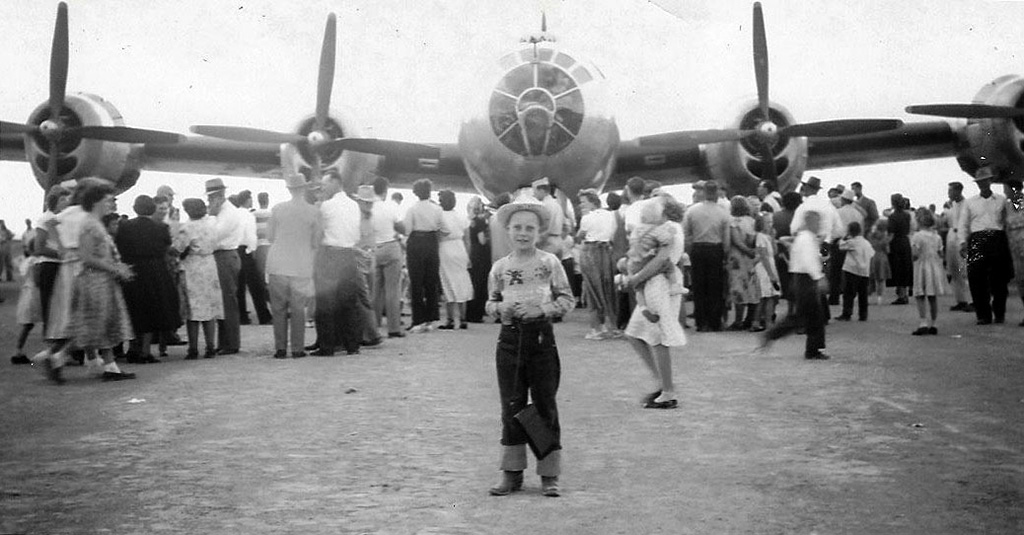
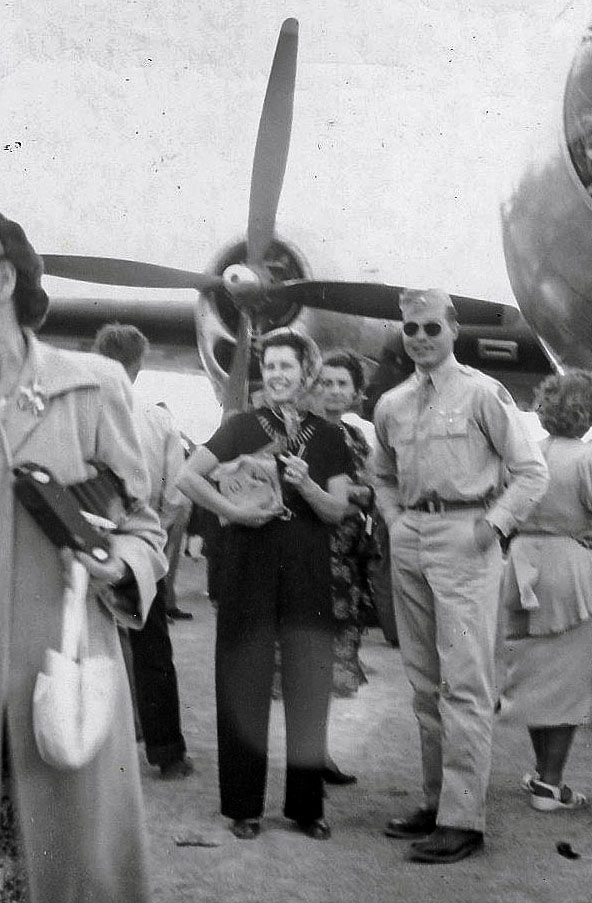
The group returned to England for another 3 months TDY. I stayed home as Mona was expecting. Paul was born in Nov 23rd of 1949. The plane I was supposed to be on ditched in the Atlantic. Col Grable’s plane. I had been made the acting adjutant and was thus responsible with dealing with the public. I received many frantic phone calls from parents, wives and girlfriends asking for information. I told them we would find them and get them back home safe – I didn’t know what else to say – and that felt right. In fact everyone was picked except for one young airman. He was seen at a distance from the rest of the crew – with his life preserver holding him up. The waves just carried him away – there was nothing anyone could do.
May 1950 brought an overseas assignment to Greenland. I was low man in the group for overseas duty and I was elected. Just after I arrived in Greenland the Korean War broke out. Within a few weeks the group was sent to Japan to Okinawa to bomb Korea. I had missed combat again which is interesting since my Patriarchal Blessing said that I would never see combat!
While in Greenland I roomed next to Father Lawler – a Catholic. I asked him to read the Book of Mormon. Father Lawler (Padre) had a private pilots license and would get angry if we went on an airdrop in the C-47 without him and he would really cuss. I told him to quit cussing or we’d tell the Pope.
I build up some good C-54 time flying to the States and Canada for supplies. C-54 and C-47 flying was much better than flying B-29’s for General Curtis Lemay and SAC. I flew the U.S. ambassador from Gothob Greenland to Thule Greenland. This was before the air base was built. At the time there was just one gravel runway.
I drove across the icecap to Weaza to visit Eskimo villages. The young men were bare from the waist down playing catch football. It was 30 degrees below zero!
I met and talked with an elderly Eskimo who was Admiral Birds guide to the North Pole. I was invited into his dugout home – the odor was horrendous – couldn’t go in.
I was later reassigned to Broakley AFB Mobile Alabama – this was the Continental Division of MATS. I flew C-74’s and C-124’s – went to school for them at McCord Field, Washington.
Out of Mobile I flew to England, Germany, Tripoli, Tule, and Kefelvic Iceland.
Once flying my leg out of Kefelvic Iceland to Harramon Field Newfounland I almost bought the farm. Just after taking off in a new C-124 the plane started pitching up and then down really violently. We could only control it with throttles and trim tabs – the horizontal stabilizers were heavily loaded. I finally was able to get the plane turned around and land at Kefelvic. The mechanics determined that there was a bucking bar left in the horizontal stabilizer. It would move around in the voids between the ribs and the weight of it would overpower any forces we were able to apply through the control column. I thought that the same problem might be the cause of a C-124 crash at Moses Lake Washington that killed 175.
I stayed at Kefleivc airport while the plane was repaired. We finally got off – it was still my flying leg – we flew to Mobile Alabama – 22 hours 35 minutes. The navigator bugged me about polygamy and how many wives I had.
In 1953 I was released from active duty after serving 7 years. I was away from home too much and my parents wanted me to stop flying, as it was too dangerous. I returned home to Riverside California and worked in an aircraft factory while waiting to be hired by the Federal Aviation Agency (FAA) for air traffic control. President Eisenhower froze all government hiring for 1 year. I started with the FAA in Nov. 1954 3 weeks after Brad was born. We moved the family to Stockton California for 9 months and Hobbs New Mexico for 9 months, Oklahoma City, Oklahoma for 3 months – all for training. After completing FAA academy training I had a choice of SLC, SEA, LAX ABQ or Oakland ARTCC (air route traffic control center). I chose Oakland because the pay was better, better chances of advancement and we liked the Bay Area. We lived in Hayward for 1 year, Centerville for 1 year, and Irvington for 5 years and moved to Sunol in 1964 and lived there for 39 years.
I enjoyed working as an air traffic controller – they were made up of 95% ex military pilots. It was a real challenge. Although boring at times because of slow traffic and at many times it was stark terror! This was before the fancy computer systems – we had to keep most all of the aircraft data in our heads.
I enjoyed taking familiarization flights with the airlines – mostly to Denver. I was able to sit in the jump seat just behind the pilot.
We were first to use radar for positive air traffic control. The work became very strenuous because of heavy traffic loads.
I retired on a medical retirement because of heart problems – had 29 years of government service.
Since both of our boys are married Mona and I enjoyed traveling in our motor homes – we had 3 over the years and visiting our families and our children and grandchildren.
Mona and I moved to Provo, Utah in February of 2003 to a big three-story home with an elevator. We have a beautiful view of the Provo valley and I watch the sunsets each evening.
I have a testimony of the truthfulness of the Gospel. I know Joseph Smith was a true prophet of God. I know Jesus Christ lives and I know God lives.
Floyd C. Bishop passed away on August 25th, 2003 in Provo, Utah. He was deeply loved by his family and is always missed. He left behind a wonderful legacy of achievement and hard work and a quiet faith that enriches the family still.
